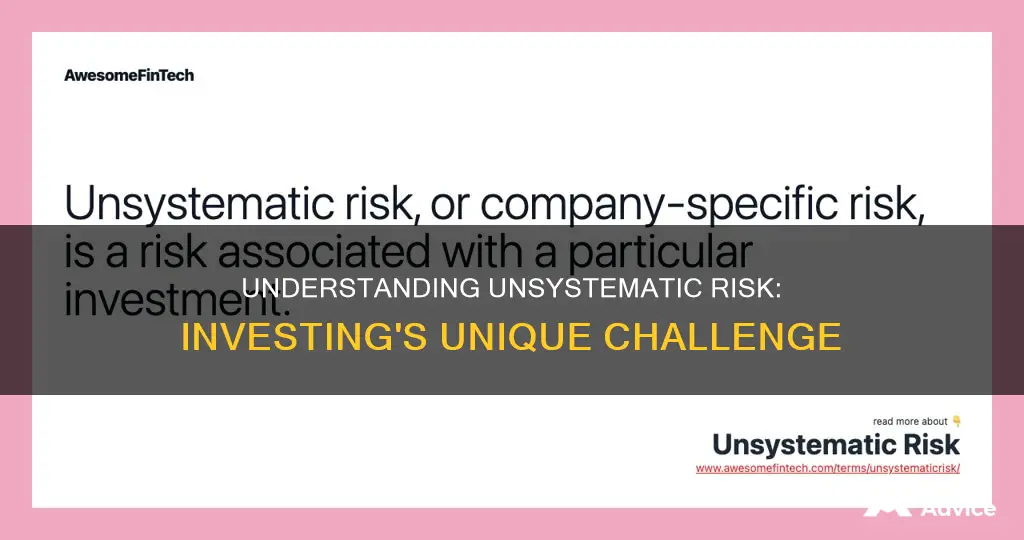
Unsystematic risk is a type of risk that only affects a particular company or industry. It is also known as specific risk, idiosyncratic risk, or company-specific risk. Unsystematic risk can be mitigated through diversification, and so is also known as diversifiable risk. Examples of unsystematic risk include a new competitor in the marketplace, a regulatory change, a shift in management, or a product recall.
| Characteristics | Values |
|---|---|
| Type of risk | Specific risk or idiosyncratic risk |
| Definition | The risk of losing an investment due to company or industry-specific hazard |
| Mitigation | Can be mitigated through diversification |
| Other names | Company-specific risk, diversifiable risk |
What You'll Learn

Company-specific risk
Unsystematic risk, also known as company-specific risk, is a risk associated with a particular investment. It is the risk of losing an investment due to a company or industry-specific hazard. Unsystematic risk can be mitigated through diversification and so is also known as diversifiable risk.
For example, a company may face a shift in management, which could be a risk factor for investors. A new competitor in the marketplace could also pose a risk, as they may have the potential to take a significant market share from the company. Regulatory changes are another example of company-specific risk, as they could drive down company sales. While investors may be able to anticipate some sources of company-specific risk, it is nearly impossible to be aware of all risks.
Equity Index: A Smart, Diversified Investment Strategy
You may want to see also

Diversifiable risk
Unsystematic risk, also known as company-specific risk, is a risk associated with a particular investment. It is also known as diversifiable risk because it can be mitigated through diversification.
Unsystematic risk represents the portion of investment risk that is unique to a firm, industry, or property. It is the risk of losing an investment due to company or industry-specific hazards. For example, a company's management capabilities, financial structure, labour strikes, and consumer preferences can all cause unsystematic risk.
Unsystematic risk is distinct from systematic risk, which is attributed to broad market factors and affects an entire economic market or a large percentage of the total market. Systematic risk, also known as market risk, is the risk of losing investments due to factors such as political risk and macroeconomic risk, which affect the performance of the overall market.
While systematic risk cannot be easily mitigated through portfolio diversification, unsystematic risk can be reduced or even eliminated by diversifying investments across different companies, industries, or properties. This is because unsystematic risk is specific to individual investments, so spreading risk across multiple investments can help to reduce the overall risk.
Examples of unsystematic risk include business risk, financial risk, default risk, and liquidity (marketability) risk. Business risk is associated with a firm's ability to operate profitably and is a major risk with individual common stocks. Other examples of unsystematic risk include the emergence of a new competitor, a regulatory change, a shift in management, or a product recall. While investors may be able to anticipate some sources of unsystematic risk, it is nearly impossible to be aware of all potential risks.
Global Share Portfolio: Invest in BizNews for Future Success
You may want to see also

Idiosyncratic risk
Unsystematic risk, also known as specific risk or idiosyncratic risk, is a category of risk that only affects an industry or a particular company. It is the risk of losing an investment due to company or industry-specific hazards. Unsystematic risk can be mitigated through diversification and so is also known as diversifiable risk. It is the portion of total risk that is unique to a firm, industry, or property.
Examples of unsystematic risk include a new competitor in the marketplace with the potential to take significant market share from the company invested in, a regulatory change (which could drive down company sales), a shift in management, or a product recall. Other factors that cause unsystematic risk include a company’s management capabilities, financial structure, labour strikes, and consumer preferences. While investors may be able to anticipate some sources of unsystematic risk, it is nearly impossible to be aware of all risks.
Building a Solid Investment Portfolio: A Beginner's Guide
You may want to see also

Business risk
Unsystematic risk is the risk of losing an investment due to a company or industry-specific hazard. It is also known as specific risk, idiosyncratic risk, or company-specific risk. Unsystematic risk can be mitigated through diversification and is therefore also known as diversifiable risk.
Loans: Saving or Investing? Understanding the Financial Impact
You may want to see also

Regulatory change
Unsystematic risk, also known as company-specific risk, is a risk associated with a particular investment. It can be mitigated through diversification and so is also known as diversifiable risk. Unsystematic risk represents the portion of investment risk that is unique to a firm, industry, or property.
East West Investment Management: What Went Wrong?
You may want to see also
Frequently asked questions
Unsystematic risk is the risk of losing an investment due to a company or industry-specific hazard. It can also be referred to as company-specific risk, specific risk, idiosyncratic risk or diversifiable risk.
Systematic risk, or market risk, is the risk of losing investments due to factors that affect the performance of the overall market. Unsystematic risk, on the other hand, only affects an industry or a particular company.
Yes, unsystematic risk can be mitigated through diversification. This is because unsystematic risk is unique to a firm, industry or property.







